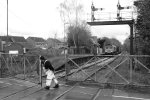I was browsing through one of my books and came across a photo from the 1950's of Huncoat station near Accrington.
At the end of the platforms in the direction of Accrington there was a level crossing, beyond it was Huncoat station signal box. This reminded me of something Chris Littleworth mentioned about my branch line of interest, there was supposed to have been a public road level crossing at the Western end of the station, but due to an access dispute the crossing was never built...
However, in anticipation of the level crossing the station's West signal box was built with 23 levers and was to have controlled it. Because the level crossing wasn't built, this West box was never opened, instead it was demolished and a simple four level ground frame replaced it.
Am I right in thinking some signal boxes had a wheel mechanism which when turned would either open or close the gates?
If some boxes did use such a "wheel", then why were most? gates manually opened and closed? by that I mean leaving the box, going down the stairs and doing it yourself.
Would there be levers in the box to lock / unlock the gates? all the old crossings I've seen it was done manually with the gates being bolted shut.
What number of tracks generally would be the maximum crossed by level crossings. two perhaps?
Thanks,
Andy.
At the end of the platforms in the direction of Accrington there was a level crossing, beyond it was Huncoat station signal box. This reminded me of something Chris Littleworth mentioned about my branch line of interest, there was supposed to have been a public road level crossing at the Western end of the station, but due to an access dispute the crossing was never built...
However, in anticipation of the level crossing the station's West signal box was built with 23 levers and was to have controlled it. Because the level crossing wasn't built, this West box was never opened, instead it was demolished and a simple four level ground frame replaced it.
Am I right in thinking some signal boxes had a wheel mechanism which when turned would either open or close the gates?
If some boxes did use such a "wheel", then why were most? gates manually opened and closed? by that I mean leaving the box, going down the stairs and doing it yourself.
Would there be levers in the box to lock / unlock the gates? all the old crossings I've seen it was done manually with the gates being bolted shut.
What number of tracks generally would be the maximum crossed by level crossings. two perhaps?
Thanks,
Andy.


